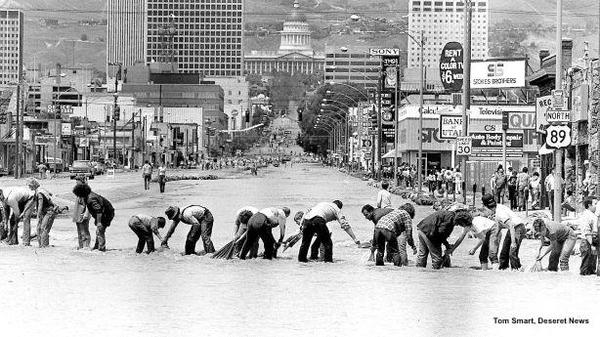Dublin Core
Title
Description
The uncharacteristically wet winter and spring seasons between 1982 and 1983 set the stage for historic floods and mudslides throughout Utah. For months, officials worried about record rainfall and increased snowpack, anticipating that warmer weather would result in disaster. Water managers throughout the state lowered reservoirs, but stood no chance against the warming temperatures and increasing runoff. Their fears proved correct on Memorial Day weekend when temperatures rose, causing massive floods from Thistle to Bountiful -- and even Great Salt Lake!
State workers responded quickly. On May 26, 1983, Salt Lake County declared an emergency and diverted rising waters from Red Butte, Emigration, and Parleys Creeks. In their race to control the floods, officials overlooked the swelling City Creek in downtown Salt Lake's Memory Grove Park. As the water rapidly rose, city engineers diverted the runoff down State Street to a storm drain a few blocks away. Thousands of volunteers responded to their call for help, hauling and stacking heavy sandbags in an effort to channel the runaway waters.
The diversion resulted in the “State Street River,” a makeshift waterway nearly two feet deep gushing down the road that leads from the Utah State Capitol building. Unsurprisingly, the new river caused major issues with commuters and downtown businesses, prompting the city to send out crews to build pedestrian bridges over the floodwaters. Recreation-lovers embraced the new river. Some cast fishing lines alongside State Street, while kayakers complained that the bridges left too little headroom to paddle downstream! Within a couple of weeks, City Creek receded and its waters channeled beneath North Temple, taking with it the State Street River.
For those who lived through the event, it isn’t just the stress of battling the flood, or the sidewalk fishermen, or even the kayakers that they remember. No, most striking were the thousands of community-minded volunteers who spent their holiday weekend filling and placing sandbags to halt flood damage in order to protect their neighborhood’s businesses and save their downtown.
Creator
Source
_______________
See SLC Fire Tech, “Salt Lake City Flood of 1983”, video footage of 1983 floods, Posted March 1, 2013; Steve Fidel, “Chiefs from ‘83 Remember Salt Lake Floods and their Impact on Conditions Now,” Deseret News, April 20, 2011; Christopher Smart, “Utah Snowpack, Weather Revives Memories of ‘83 Floods,” The Salt Lake Tribune, May 4, 2011; “Floods are Part of Wasatch Front’s Weather History,” History Blazer, June 1995; Linda Sillitoe, A History of Salt Lake County. Salt Lake City, UT: Utah State Historical Commission, 1996; Linda Sillitoe, “Floods,” Utah History to Go; LeRoy W. Hooton, “Memorial Day Weekend 1983: Streets to Rivers,” SLC Docs, May 28, 1999; Adam Forgie, “Remembering the Floods of 1983,” KUTV Photo Gallery, May 12, 2016; Ted Wilson, “Letter: Remember How We Stood Together in the Flood of 1983,” The Salt Lake Tribune, March 31, 2020; “A Look Back: Photos of the the Utah Floods of 1983,” The Salt Lake Tribune, April 7, 2013.

